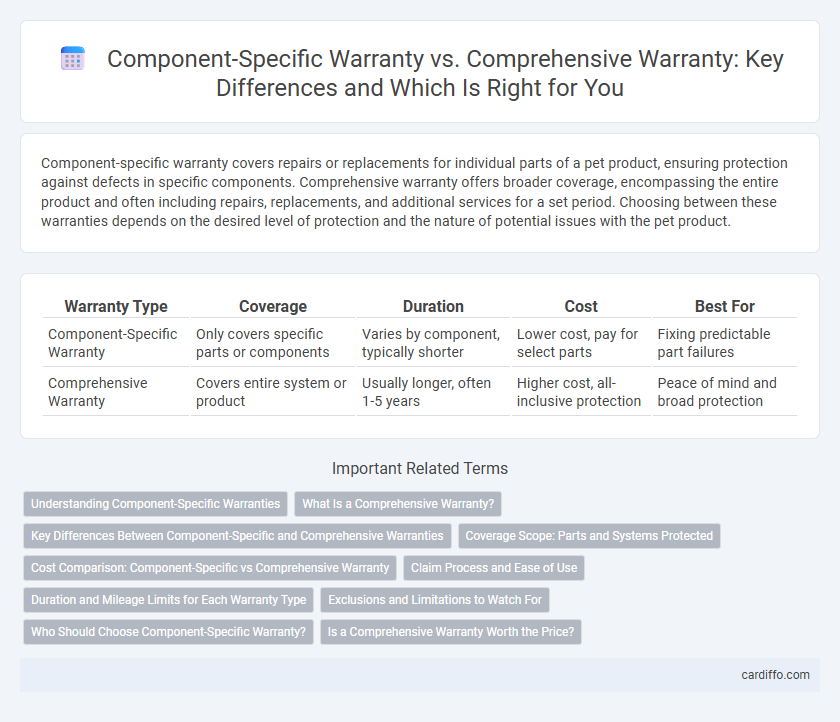Component-specific warranty covers repairs or replacements for individual parts of a pet product, ensuring protection against defects in specific components. Comprehensive warranty offers broader coverage, encompassing the entire product and often including repairs, replacements, and additional services for a set period. Choosing between these warranties depends on the desired level of protection and the nature of potential issues with the pet product.
Table of Comparison
| Warranty Type | Coverage | Duration | Cost | Best For |
|---|---|---|---|---|
| Component-Specific Warranty | Only covers specific parts or components | Varies by component, typically shorter | Lower cost, pay for select parts | Fixing predictable part failures |
| Comprehensive Warranty | Covers entire system or product | Usually longer, often 1-5 years | Higher cost, all-inclusive protection | Peace of mind and broad protection |
Understanding Component-Specific Warranties
Component-specific warranties cover repairs and replacements for particular parts, such as the engine, transmission, or electrical systems, offering targeted protection for critical vehicle components. These warranties typically last longer for covered parts compared to comprehensive warranties but may exclude other vehicle systems, requiring owners to understand the specific coverage scope. Understanding component-specific warranty terms helps consumers avoid unexpected costs by clarifying which parts are protected and for how long.
What Is a Comprehensive Warranty?
A comprehensive warranty covers a wide range of components and systems within a product, offering broad protection against defects and malfunctions for an extended period. Unlike component-specific warranties that focus on individual parts, comprehensive warranties include both major and minor elements, reducing out-of-pocket repair costs. This type of warranty enhances consumer confidence by providing extensive coverage and minimizing unexpected expenses throughout the product's lifecycle.
Key Differences Between Component-Specific and Comprehensive Warranties
Component-specific warranties cover repair or replacement of particular parts like the engine or transmission, limiting protection to identified components. Comprehensive warranties provide broader coverage, encompassing most vehicle systems and parts, often including labor and additional services. Key differences include scope of coverage, duration, and cost, with component-specific warranties generally being more affordable but less inclusive than comprehensive options.
Coverage Scope: Parts and Systems Protected
Component-specific warranty covers only designated parts or systems, such as the engine or transmission, limiting protection to identified components. Comprehensive warranty extends coverage to most, if not all, vehicle parts and systems, including electrical, mechanical, and body components. This broader scope reduces out-of-pocket costs for repairs and increases overall vehicle protection.
Cost Comparison: Component-Specific vs Comprehensive Warranty
Component-specific warranties typically cost less upfront because they cover only particular parts, reducing initial expenses and targeting critical components with higher failure rates. Comprehensive warranties involve higher premiums as they provide extensive coverage for nearly all parts and labor, offering broader protection and minimizing out-of-pocket repair costs over time. Choosing between the two depends on balancing immediate cost savings of component-specific plans against the long-term financial security offered by comprehensive warranties.
Claim Process and Ease of Use
Component-specific warranties streamline the claim process by focusing on individual parts, making it easier to identify and submit claims for defects related to specific components. Comprehensive warranties cover a broader range of issues, often simplifying claims by reducing the need to determine the exact faulty part but potentially increasing processing time due to the wider scope. Customers seeking quick and straightforward resolution may prefer component-specific warranties, while those valuing extensive coverage benefit from the holistic protection offered by comprehensive warranties.
Duration and Mileage Limits for Each Warranty Type
Component-specific warranties typically offer coverage limited to particular parts like the engine or transmission, with duration ranging from 5 to 10 years and mileage limits between 60,000 to 100,000 miles. Comprehensive warranties provide broader protection, often covering most vehicle components for shorter periods, usually 3 to 5 years, and mileage limits around 36,000 to 60,000 miles. Vehicle owners should carefully compare these duration and mileage parameters to select the warranty type that best fits their driving habits and vehicle usage.
Exclusions and Limitations to Watch For
Component-specific warranties often exclude coverage for parts outside the targeted area, such as wear-and-tear items or incidental damages, limiting protection strictly to the specific component. Comprehensive warranties provide broader coverage but typically feature exclusions like improper use, unauthorized repairs, and consequential damages, which can void claims. Consumers should closely examine the fine print for limitations on mileage, time periods, and specific conditions that may affect warranty validity.
Who Should Choose Component-Specific Warranty?
Component-specific warranty is ideal for consumers looking to protect high-cost or frequently replaced parts without paying for full coverage, such as electronics or mechanical components in vehicles. Homeowners with newer installations like HVAC systems or solar panels benefit by targeting warranty costs precisely to expensive components prone to failure. This type of warranty appeals to budget-conscious buyers seeking focused protection and lower premiums compared to comprehensive warranty plans.
Is a Comprehensive Warranty Worth the Price?
A comprehensive warranty typically covers a wider range of components and potential repairs, offering greater peace of mind compared to component-specific warranties, which only cover certain parts. The cost of a comprehensive warranty is higher, but it may save significant expenses on unexpected breakdowns and extensive repairs over time. Consumers should evaluate the likelihood of multiple component failures and consider the price difference to determine if the comprehensive coverage justifies the investment.
Component-Specific Warranty vs Comprehensive Warranty Infographic

 cardiffo.com
cardiffo.com